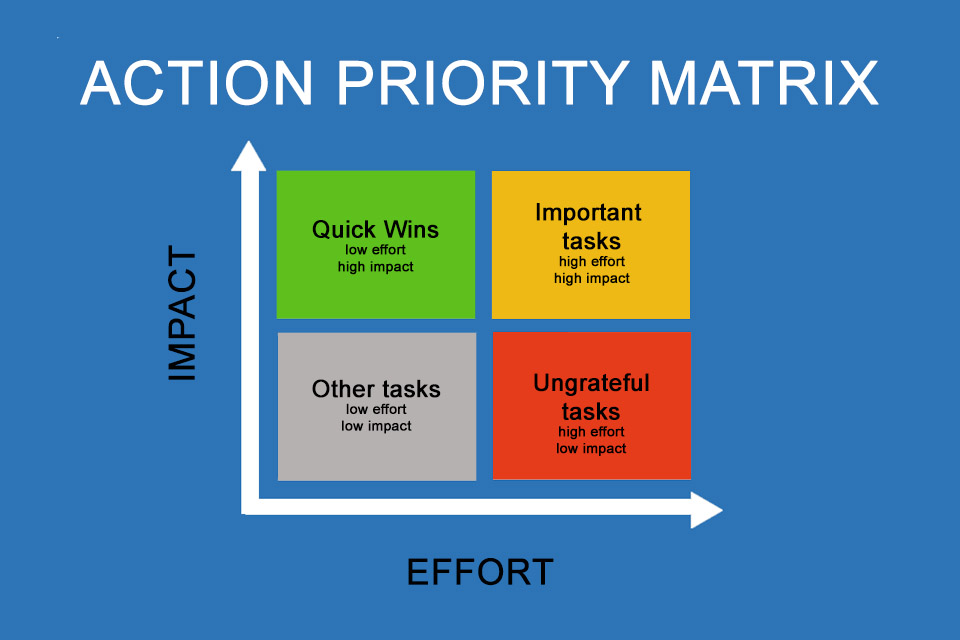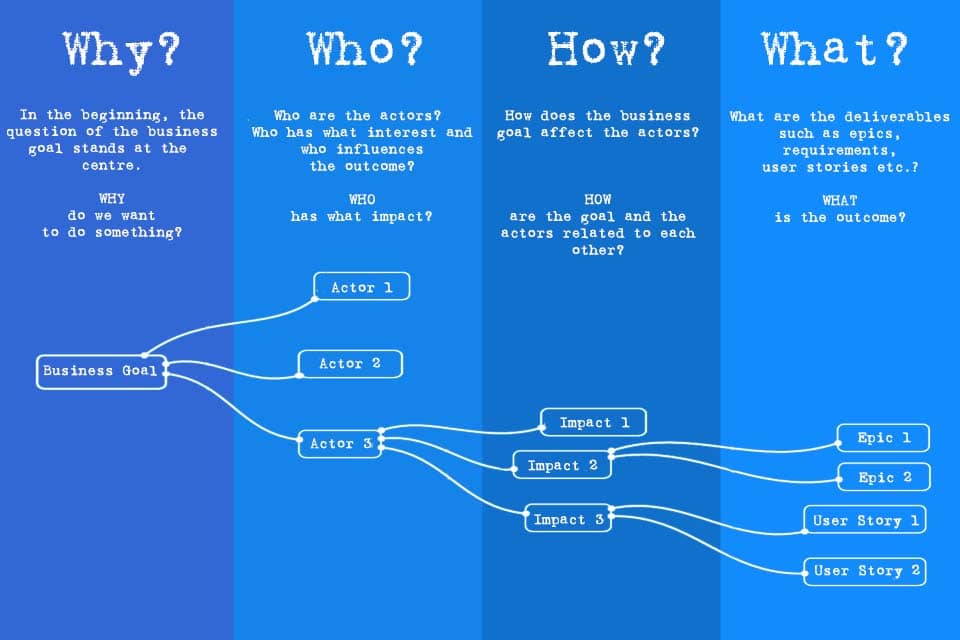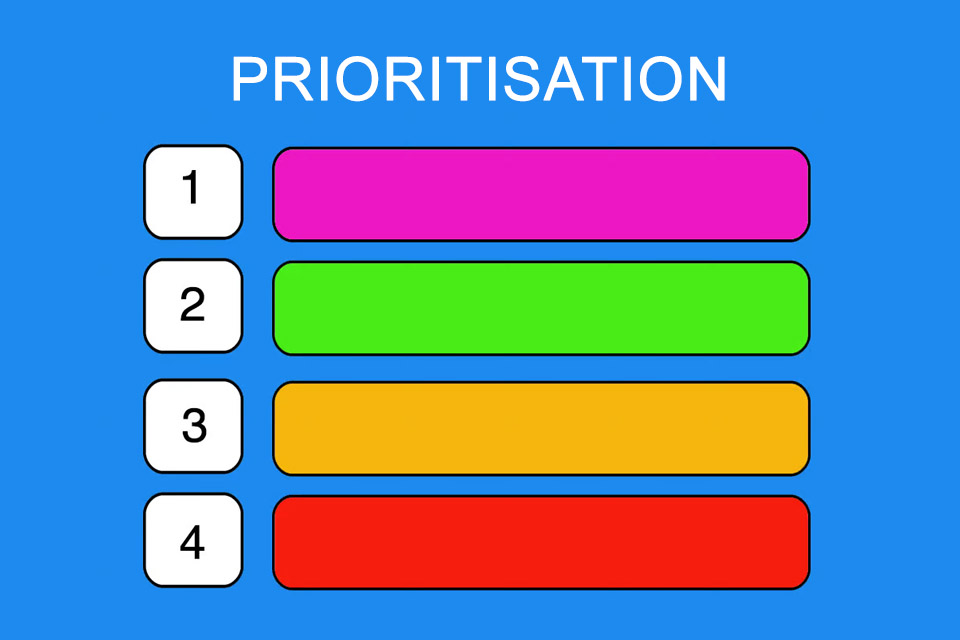What is an Action Priority Matrix?
Action Priority Matrix – prioritising activities according to effort and impact
In a world full of ideas and possibilities, successful implementation is just as crucial as the concept itself. A brilliant concept, a high-calibre team and sophisticated tools are important ingredients, but are not enough on their own. Implementation requires more than just theoretical knowledge; it requires the ability to prioritise. It is important to know which activities need to be completed when and when one action can be postponed in favour of another. A simple and useful tool is the Action Priority Matrix. It helps to categorise activities based on effort and impact and thus provides the basis for subsequent prioritisation.
The structure of the Action Priority Matrix
The Action Priority Matrix – also known as PICK Matrix or Impact Effort Matrix – is a two-dimensional representation with the axes “effort” and “impact” and four quadrants:
Quadrant 1: Quick wins (high impact, low effort)
This quadrant comprises tasks of high importance and immediate benefit, but which require comparatively little effort. These are tasks that can be completed quickly and require little effort or cost. These tasks are often referred to as quick wins. An example of this would be setting up a website redirect if the URL of a piece of information has changed, or rectifying minor errors in an application.
Approach: These tasks can usually be tackled and prioritised immediately, as they require relatively little effort and quickly have a positive effect.
Quadrant 2: Important tasks (high impact, high effort)
This quadrant includes tasks of high importance and great benefit, but which require considerable effort. These activities are of great importance for the long-term success of a project or company. For example, the development of a new feature in software that significantly improves customer satisfaction could fall into this quadrant.
Approach: It makes sense to pay a lot of attention to these tasks, as on the one hand they have a major impact and are therefore a high priority, but at the same time they also involve a relatively large amount of effort and cost. The implementation of the task often demands dedicated planning, a definition of acceptance criteria and success monitoring.
Quadrant 3: Other tasks (low impact, low effort)
This quadrant contains actions that are of minor importance but require comparatively little effort. These actions can easily be postponed or delegated as they do not make a significant contribution to overall success. An example of this could be updating documentation, which is important but does not have a direct impact on business success.
Approach: These actions should be delegated or postponed to free up resources for important projects.
Quadrant 4: “Ungrateful” tasks (low impact, high effort)
This quadrant includes activities that require considerable effort but have little benefit or impact. These activities should be avoided or automated as far as possible so as not to tie up valuable resources unnecessarily. For example, these could be administrative tasks that are time-consuming but make no direct contribution to business success.
Approach: These activities should either be delegated, automated or avoided completely to free up time and energy for more important projects.
Ideally, your project plan should consist of a variety of tasks that fall into quadrants 1 and 2, as these offer a high benefit with relatively little effort. However, managers often have to prioritise and juggle tasks in each of the quadrants. By clearly prioritising and using the Action Priority Matrix, they can ensure that resources are used effectively to achieve the best results.
Advantages and disadvantages of the Action Priority Matrix
The use of the Action Priority Matrix offers a number of advantages:
- Unlike static lists, it allows for dynamic adaptation to changing circumstances and priorities. It takes into account contextual nuances and allows you to focus on the most urgent and impactful tasks.
- The visual representation of the matrix can help reduce stress and overload by providing a clear structure and a sense of control. Consciously deciding which tasks to prioritise can also boost self-esteem.
- It is not only suitable for individual time management strategies, but also for teamwork, as it allows teams to prioritise, assign tasks and track progress together, leading to improved communication and collaboration.
Where there are advantages, there are also disadvantages:
- Evaluating tasks based on effort and impact often requires subjective judgement, which can lead to uncertainty and misjudgement. In complex working environments in particular, it can be difficult to make a standardised assessment.
- Tasks with low effort and impact can easily be overlooked or neglected if they are not prioritised appropriately. This can lead to important long-term strategic goals being lost sight of.
- Emphasising tasks with quick results (high impact, low effort) in the matrix can lead to long-term, but more complex tasks and goals being neglected. This could affect the long-term strategic direction of a team or organisation.
Action Priority Matrix and Eisenhower Matrix in comparison
The Action Priority Matrix and the Eisenhower Matrix are both time management tools that help to prioritise tasks. The main difference between the two lies in the way they categorise tasks.
The Eisenhower Matrix is based on two criteria: Urgency and Importance. Tasks are categorised into four quadrants according to these criteria: Urgent and Important, Urgent and Not Important, Not Urgent and Important, and Not Urgent and Not Important.
The Action Priority Matrix, on the other hand, takes into account the effort and impact of a task. It divides tasks into four quadrants: quick wins (high impact, low effort), important projects (high impact, high effort), additional projects (low impact, low effort) and “ungrateful” tasks (low impact, high effort).
While the Eisenhower Matrix focuses on the urgency and importance of a task, the Action Priority Matrix takes into account the effort and impact of a task in order to enable a more differentiated prioritisation. In short: both tools are sisters in spirit that use different criteria for prioritisation.
Impulse to discuss
How does the integration of quick wins affect the long-term achievement of goals and how can organisations ensure that short-term successes do not compromise their long-term strategy?
Notes:
If you like the article or would like to discuss it, please feel free to share it in your network. And if you have any comments, please do not hesitate to send us a message.
Here you can find a Action Priority Matrix template for Miro.
And here you can find additional information from our Smartpedia section:



